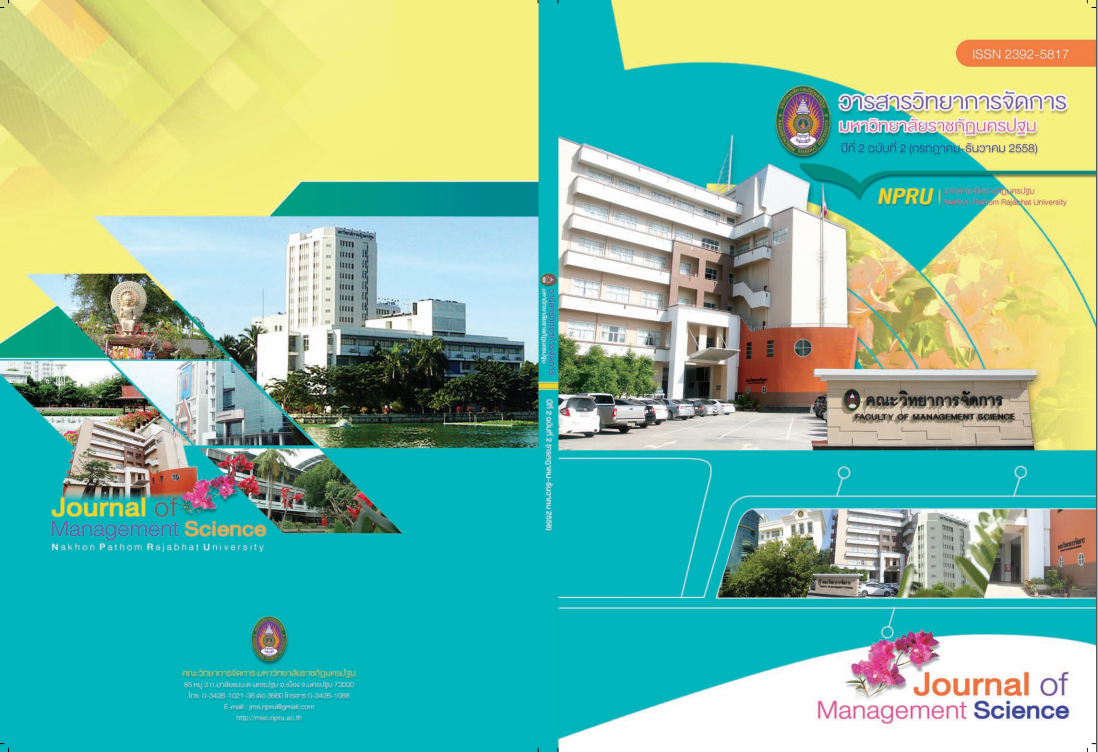Guidelines for prepare to career preparation of Silpakorn University students towards Asean Economics Community
Main Article Content
Abstract
The purposes of this research were to: 1) study the level of readiness of Silpakorn University students’ career preparation for the ASEAN Economic Community; 2) compare the readiness of Silpakorn University students’ career preparation as classified by personal factors; 3) analyze the educational environment affecting the readiness of Silpakorn University students’ career preparation; and 4) recommend the guidelines on readiness of Silpakorn University undergraduate students’ career preparation. The sample was 370 undergraduates in the final year of study, derived by stratified random sampling as distributed by field of studies and six purposively selected key informants. The research instruments used for collecting data were a questionnaire and an in-depth interview constructed by the researcher. The statistics employed for data analysis were frequency, percentage, mean, standard deviation, t-test, one-way analysis of variance,
correlation coefficient, stepwise multiple regression analysis and content analysis.
The findings of this research were as follows:
1) The level of readiness of Silpakorn University students’ career preparation was at a high level in all aspects.
2) The undergraduates students with difference in gender, GPA,residence and average family income had different effect on the readiness of career preparation with statistical significance at a .05; while there were no statistical difference in field of studies and parents’ occupation.
3) All aspects of educational environment together predicted the readiness of Silpakorn University students’ career preparation at the percentage of 86.60 with statistical significance at .05.
4) Guidelines for students’ career preparation were divided into 3 domains. First in cognitive domain, it included teachers’ current knowledge acquisition through promoting collaborative teaching among ASEAN countries; teaching the subjects with English media; and the implementation of innovative Information Technology Services (ITS) for students. Second in the affective domain, it included the motivation of students to learn; the creation of a good educational environment; and the organization of activities to develop students’ morality and ethics. Third in psychomotor domain, it included the emphasis on practices and problem-solving skills; the use of teaching facilities to enhance students’ skills; and involvement of the Student Internship Programme (SIP) in ASEAN countries.
Article history : Accepted 2 June 2015
SIMILARITY INDEX = 1.89
Article Details
The views and opinions of the article appearing in this journal are those of the author. It is not considered a view and responsibility of the editorial staff.
References
ชิดชนก ทองไทย. ( 2556). การรับรู้และทัศนคติที่มีผลต่อความพร้อมในการเข้าสู่ตลาดแรงงานประชาคมอาเซียนของนักศึกษา. ปริญญาโทมหาวิทยาลัยศรีนครินวิโรฒ. บัณฑิตวิทยาลัยมหาวิทยาลัยศรีนครินทรวิโรฒ. วิทยานิพนธ์ปริญญาบริหารธุรกิจมหาบัณฑิต. สาขาวิชาการจัดการบัณฑิตวิทยาลัยมหาวิทยาลัยศรีนครินทรวิโรฒ.
นันทพัทธ์ โนนศรีเมือง, อำภาศรี พ่อค้า. (2556). ความสัมพันธ์ระหว่างสภาพแวดล้อมทางการศึกษากับแรงจูงใจในการเรียนของนักศึกษามหาวิทยาลัยเทคโนโลยีราชมงคลอีสาน วิทยาเขตกาฬสินธุ์. กาฬสินธุ์ : รายงานการวิจัย มหาวิทยาลัยเทคโนโลยีราชมงคลอีสานประจำปีงประมาณ พ.ศ.2556, 2556
พระอโนชาสิมพา. ( 2553). ทัศนะของนักศึกษาระดับปริญญาตรีที่มีต่อสภาพแวดล้อมของมหาวิทยาลัยมหามกุฏราชวิทยาลัยวิทยาเขตมหาวชิราลงกรณราชวิทยาลัย. ปริญานิพนธ์การศึกษามหาบัณฑิตสาขาวิชาการอุดมศึกษาบัณฑิตวิทยาลัยมหาวิทยาลัยศรีนครินทร์วิโรฒ.
มหาวิทยาลัยศิลปากรกองกิจการนักศึกษา. (2557). คุณลักษณะบัณฑิตที่พึงประสงค์. ค้นเมื่อ 18 สิงหาคม 2557 จาก https://www.kongkit.su.ac.th/kksu/index.php?option=com_content&view=article&id=47%3 Avision&catid=29%3Athe-cms&Itemid=1.
________กองบริการการศึกษา. (2557). ระบบการศึกษามหาวิทยาลัยศิลปากร. ค้นเมื่อ 18 สิงหาคม 2557. จาก https://reg2. su.ac.th/registrar/studentByProgram.asp?acadyear=2553&facultyid=0&levelid=1
________กองแผนมหาวิทยาลัยศิลปากร. (2556). รายงานประจำปีการศึกษา2553-2554. ค้นเมื่อ 10 สิงหาคม 2557. จาก https://www.plan.su.ac.th/Research/Databest/SARSU(2553-2554).pdf.
เศรษฐชัยอันสมศรี, นัฐกานต์ ขำยังและพลอย เจริญสม. (2556). ฐานข้อมูลราชกิจานุเบกษาและการพัฒนากฎหมายอิเลคทรอนิคส์. ค้นเมื่อ 20 กันยายน 2557. จาก https://61.19.241.70/rkj/frmlawpreview4. aspx?lawgroupId=212666
สุบินยุระรัช, เชียง เภาชิต, สุรเดช แสงเพ็ชร และไพบูลย์ สุขวิจิตร.รายงานวิจัยเรื่องความพร้อมในการพัฒนาบัณฑิตของสถาบันอุดมศึกษาเอกชนในประเทศไทยเพื่อรองรับประชาคมเศรษฐกิจกิจอาเซียน.(กรุงเทพฯ : สมาคมสถาบันอุดมศึกษาเอกชนแห่งประเทศไทย (สสอท.), 2554): 29-88.
อรวรรณ สีลวานิช. (2554). ความพร้อมของนักศึกษาคณะสังคมสงเคราะห์กับการเข้าสู่ตลาดแรงงานประชาคมอาเซียน. สารนิพนธ์มหาบัณฑิต สาขาพัฒนาแรงงานและสวัสดิการ บัณฑิตวิทยาลัย. มหาวิทยาลัยธรรมศาสตร์.
Best, J.W. & Kahn, J.V. (1998). Research in Education. (8th ed.) Boston : Allyn & Bacon.
Bloom, B.S. (1976). Human Charactcristic and School Learning. New York : McGraw-Hill Book Co.


